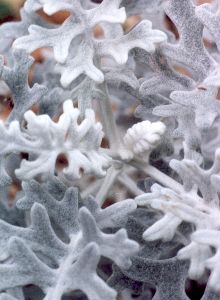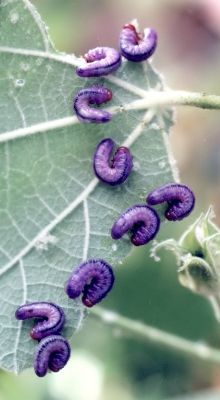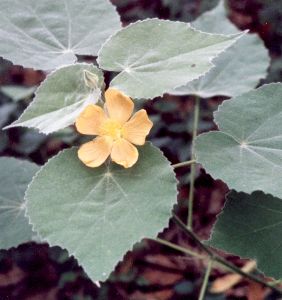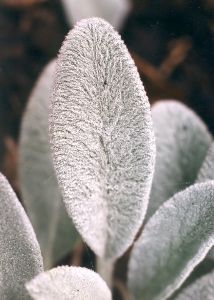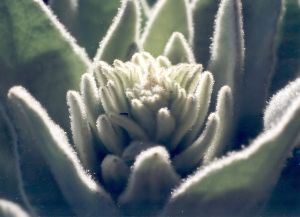Fuzzy Plants
by Valerie (June 27, 2000)
revised September 7, 2003
Some plants in our gardens appeal to the visual sense, some to the olfactory, but some are definitely tactile pleasures. We have several plants that are fuzzy, or furry-feeling, and the textures are as varied as other plants' odors or hues.
Dusty miller (Senecio maritima) is a perennial in our area and grows very slowly. Our plants are two years old and haven't yet bloomed. The leaves are hairy but not very soft; they are more like felt than fur. The plants are very drought resistant and are an interesting contrast to nearby green foliage.
A very different texture can be found on the velvetleaf mallow (Wissadula holosericea). The leaves really do feel like velvet and are so soft that you almost don't feel them. This native wildflower is a perennial that often grows in marginal habitat and therefore doesn't get very big. However, when given a little extra water, the somewhat woody stems get to be about three feet tall. The flowers are less than two inches across, but are a pleasing yellow, and the plant blossoms profusely in shady areas. These blossoms are edible and can be eaten raw or fried. It is very easy to grow from seed and that is how we acquired our plants. In the past, no pests seemed to eat the leaves of this plant, but just a few days ago I discovered a defoliated stem, with dozens of bright blue sawfly larvae lined up under the edges of partially eaten leaves. They were a beautiful color: sort of like lapis lazuli and about three fourths of an inch long, each one curled into a half circle (since I had definitely disturbed them). These are a species of sawflies (Cimbex sp.), and they are not all that common in our yard. Shortly after the photo was taken, they all disappeared.
The aptly named lamb's-ear (Stachys byzantina) is a low-growing, spreading perennial. It's leaves are very woolly feeling and the shape certainly looks like little lambs' ears. Although this plant doesn't bloom very often, I started our clump from seed collected from a flowering batch. I put the seeds in several different places but only one was suitable for germination. The plant does best when it is rather dry, but not in direct sun. Over the past few years, it has slowly spread by underground runners.
The last plant here is the fuzziest: common mullien (Verbascum thapsus). It is such a big and impressive plant that I tried numerous times to collect seed and get it started in our gardens, after seeing it growing wild in fields and along roads. It never grew, so one spring I collected a tiny plant that was growing in a construction site and transplanted it. It grew quite large, with a four foot tall flower stem covered with yellow flowers. At the end of the summer it died. All the seeds it produced never germinated either, but it was an interesting experiment. Mullien has other names including Jupiter's staff, velvet dock, Indian tobacco and flannel leaf. It has medicinal properties and was used historically in many folk remedies. |
